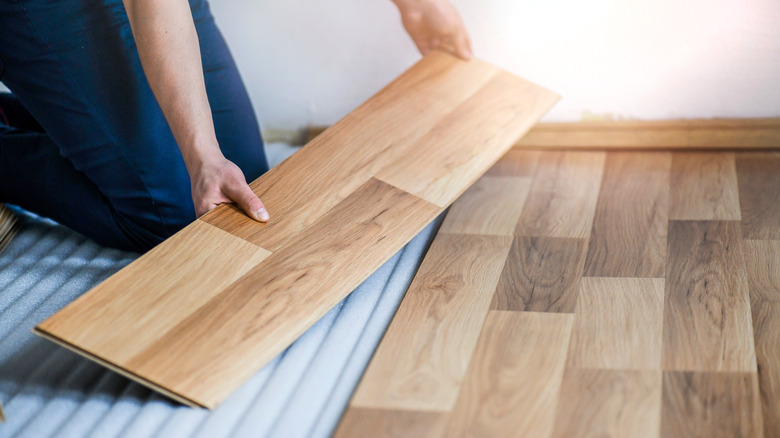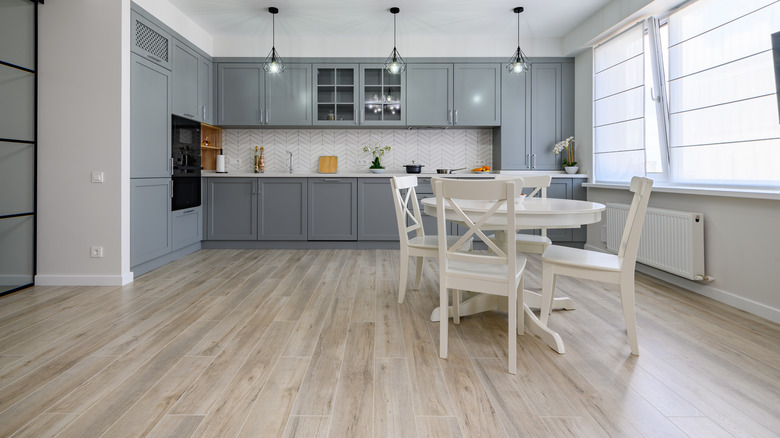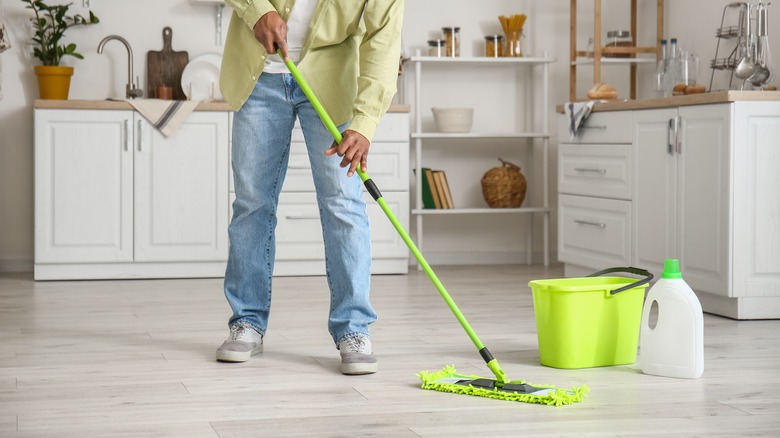The Pros And Cons Of Installing Laminate Flooring In Your Kitchen
The secret to getting the luxurious look of real hardwood or natural stone kitchen floors at a fraction of the cost is to use laminate flooring. Gone are the days when the only laminate options came with a cheap plastic finish and hurt the room's design appeal. Now, you can have the best of both worlds and install a durable and stylish yet low-cost floor. But while laminate is inexpensive and easy to install, the material isn't ideal for every kitchen as it can be susceptible to damage, and once damaged, the planks need to be replaced.
A laminate floor might be a good steal if you plan to DIY your kitchen revamp and want something durable. However, if a high-end look that can stand the test of time is more of a priority, it might not be the best flooring option for your kitchen, especially if you plan to sell your property anytime soon. You'll want to consider the cost, design, functionality, and maintenance of the flooring to ensure you're making the right decision for your home.
Laminate flooring gives you a beautiful kitchen for less
A big appeal of laminate flooring is that it's inexpensive. On average, the planks range in cost from $0.79 to $3.00 per square foot, while tile and hardwood average $2 and $2.40 per square foot, respectively. It's important to note that those prices don't include paying a professional for installation. Luckily, laminate floors are easy to install as they don't require nailing or gluing to the subfloor, making it a DIY-friendly project. You can install laminate floors yourself to make the purchase even more cost-effective.
Laminate flooring comes in a range of designs, too. So, no matter your kitchen's aesthetic, there's a look available to satisfy your taste. Finally, once the laminate floor has been laid, it's easy to clean. A mop dampened with water and mild soap will take care of your spills. However, using scratch-, water-, and stain-resistant laminate is crucial to making sure your floors will look their best for as long as possible. Good-quality laminate floors are durable, especially with proper maintenance. But while pets, children, and heavy foot traffic shouldn't be an issue, constant moisture can be a big problem.
Laminate floors aren't the most practical
Laminate floors don't take kindly to standing water, and after the bathroom, the kitchen is one room where water is usually the most present. A drip or two from a potted plant or dishwasher won't cause any harm, but constant moisture can lead to warping. The interior of the laminate planks is made from composite wood, which can rot when exposed to puddles of liquid. Because of this, you'll need to be mindful, as a minor leak or spill can turn into a partial floor replacement.
Plus, depending on the wear of the floor, it might be impossible to find new laminate that will perfectly match your existing planks. This leads to another downside: laminate floors can't be refinished or repaired like hardwood and tile. Once they lose their shine or shape, the only solution is to replace the damaged floorboards.
Finally, if you plan to put your house on the market, laminate isn't the best investment. It's a flooring choice that will make it harder to sell your home because it's usually perceived as low-quality. With the proper maintenance, laminate kitchen floors are great for a forever home, but maybe not for a leak-prone house for sale.



